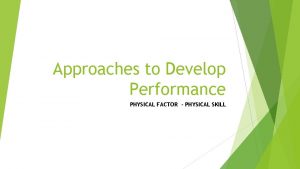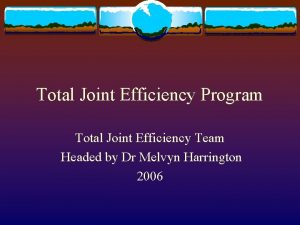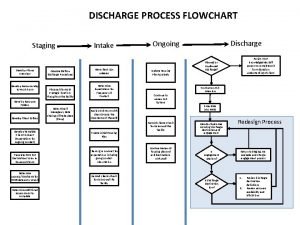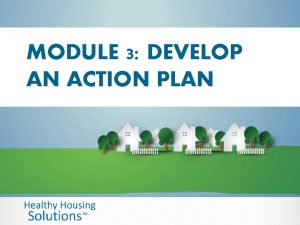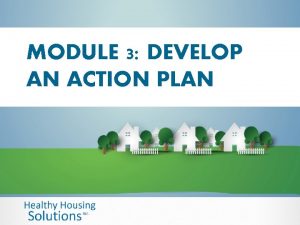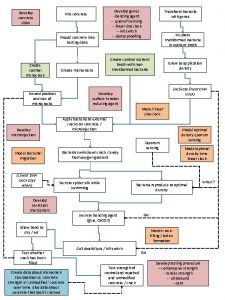How to Develop a Running Program Running Efficiency





































- Slides: 37

How to Develop a Running Program & Running Efficiency By XXXXXX Masters Runner Do not copy or reproduce without permission from XXXX, XX

Twelve Key Ingredients to Develop a Life Time Running Program You Will Enjoy 1. Warm Up and Warm Down 2. Perform Strengthening and Flexibility Exercises 3. Practice Proper Running Form 4. Gradually Increase Workload/Running to Increase Your Aerobic Base 5. Build Power with Hill Work 6. Develop Speed by Running Fartlek 7. Balance Aerobic and Anaerobic Running 8. Use Speed Sessions to Polish and Refine Your Running Form 9. Allow Ample Recovery 10. Maintain Consistency in Running 11. Cross Train 12. Maintain Proper Nutrition

Warm Up & Warm Down • Warming up before running and warming down after running will improve running efficiency and prevent needless injuries. • Runners should walk or run slowly for a few minutes (two to three minutes) before you start your work out and walk for 5 minutes after you finish your run. • Walking or running slowly gradually increases your heart rate, and warms up the muscles and tendons before running. • Walking or running slowly after your workout allows the heart rate to return to normal, prevents dizziness, and allows the body to cool down. • This enhances the effectiveness of strengthening and flexibility exercises known as the “Magic Six” developed by Dr. George Sheehan.

15 Running Exercises • Dr. George Sheehan recommends that runners perform strengthening and Flexibility Exercises before and after running. • These exercises prevent knee, shin, and back injuries, and will improve running efficiency. Dr. Sheehan recommended six exercises. • I have added 9 exercises to strengthen calves, shins, hamstrings, hip flexors, and add more flexibility. I named these exercises: “Fifteen Running Exercises. ”

15 Running Exercises Perform Three Sets of Each Exercise Before and After Every Run #1 Sit on a bench. Place weight (using line & a 5 pound weight (small frame) or an 8 pound weight (large frame) ) on foot. Raise toe and hold weight for eight seconds. Repeat same exercise with opposite foot. Perform three sets with each leg.

15 Running Exercises Perform Three Sets of Each Exercise Before and After Every Run #2 Sit on a bench. Place weight (using line & 5 pound weight (small frame) or 8 pound weight (large frame) ) on foot. Raise leg and hold leg straight out for eight seconds. Repeat same exercise with opposite leg. Perform three sets with each leg. This exercise strengthens the quadriceps, patella tendon, keeps the patella on the right track, and helps prevent chondromalacia.

15 Running Exercises Perform Three Sets of Each Exercise Before and After Every Run #3 Lay on Your back. Bring one knee to chest and hold for eight seconds. Repeat exercise with opposite knee. Perform three sets. As you continue to run, the back muscles tighten. This exercise keeps back muscles loose and helps prevent back injuries.

15 Running Exercises Perform Three Sets of Each Exercise Before and After Every Run #4 Strengthen and stretch out your calves by leaning and pushing against a wall or tree. Bring one knee forward. Hold for eight seconds. Perform three sets with each leg. In order to lean forward in running, the ankles, and the achilles tendon must be strong and very flexible.

15 Running Exercises Perform Three Sets of Each Exercise Before and After Every Run #5 & # 6 Do eight crunches and eight elbow to knee flexes. Perform three sets. These exercise strengthens the abdominals and warms up hip and knee joints. Strong abdominals keep the core of the body strong, enhances your breathing, and helps prevent back injuries.

15 Running Exercises Perform Three Sets of Each Exercise Before each run #7 Place one knee forward and tuck the shin underneath. Extend the opposite leg back. Hold for 8 seconds. Complete for both legs. This relaxes the quadriceps and the hip flexors. It enables the runner to extend the leg back and maximize the extension and range of motion in running. Balance on one leg and hold opposite leg out. This teaches balance and aids in the extension of the hind leg in running. Leaning at the finish wins races.

15 Running Exercises Perform Three Sets of Each Exercise every other day #8 & #9 With two hands and one knee on the ground, hold the opposite leg out. Hold for eight seconds. In same position, point foot upward. Raise foot 6 inches, return quadricep to parallel position. Repeat 8 times. Perform three sets for each of these exercises. Repeat for opposite leg. Strengthens buttocks, back muscles and hamstrings. Exercises also aids in building power and enhancing the hind legs range of motion.

15 Exercises to Run Perform Three Sets of Each Exercise Before and After Every Run #10 Standing upright, bring the foot behind and hold the heel of the foot next to the buttock. Hold for eight seconds. Repeat exercise with the opposite foot. Perform three sets with each leg. As you continue to run, the hip flexor tightens and hinders you from kicking the leg and foot back. This exercise ensures you will have the range of motion to run efficiently.

15 Running Exercises Perform Three Sets of Each Exercise Before every Run #11 Standing on the balls of your feet. Walk on the balls of your feet for thirty to 60 seconds. Repeat three times. This exercise strengthens the calves and the Achilles tendon.

15 Running Exercises Perform Three Sets of Each Exercise Before Every Run #12 Walk on the heels of your feet for thirty to sixty seconds. Repeat three times. This exercise prevents shin splints. As you run, the calves get stronger, but the shin muscles weaken. This exercise keeps the muscles in front of the shin in balance with the calf muscles.

15 Running Exercises Perform Three Sets of Each Exercise Before and After Every Run #13 & #14 Do Eight forward leg Kicks (walking or running). This prepares the Quadriceps and hamstrings for running and helps establish the muscle memory for running. Place the leg on a hip high object and stretch out the hamstring. Hold for eight seconds. Perform three sets. Repeat for the opposite leg.

15 Running Exercises Perform Three Sets of Each Exercise Before Every Run #15 Do Eight Walking Butt Kicks. This prepares the hamstrings for running and helps establish the muscle memory for running. It also teaches balance.

Proper Running Form Running with the Proper Running Form will: • Make running enjoyable and easy. • Help your run countless miles with less fatigue and reduce the recovery period. • Reduce the probability of injury. • Enhance the use of gravity and the momentum of running to move your forward. • Make you feel like you are riding a bike. • Maximize the use of Physics in Running. Driving the knee forward (versus foot) and extending your leg behind you. • Improve your running times and overall performance in races with less effort.

Proper Running Form Proper running form is critical to running efficiency and economy. Once you start running, the momentum of your running will naturally carry you forward if you stand tall and lean forward at the ankles and the hips. To help you stand tall, fix your eyes on a position 60 meters ahead of you and do not look down at your feet.

Proper Running Form • The easiest way to ensure you are running efficiently is to think of your self as a wheel. • The hips are the center of the wheel and your feet are the rim of the wheel. The hips should not move up and down but stay very close to an imaginary parallel line to the ground. • Land lightly on the outside of your heel or mid foot, and pronate to the ball of your foot. As you transfer your weight to the ball of your foot, lean forward at the ankle and hip. As your hip and knee comes forward, drive one knee forward and toe off from the opposite foot on the ground. • Do not attempt to pick yourself up. This will only tighten your calves and Achilles tendon and waste needless energy. Running is a reflexive motion. You will naturally rebound off the ground. Your hands should remain relaxed and the fingers should slightly tip your running shorts. “Toe off. ” to maximize your range of motion.

Proper Running Form: The Landing Distance Running Technique Land lightly on the bottom/outer edge of your heel or mid foot and pronate to the ball of your foot. As you transfer your weight to the ball of your foot, lean forward at the ankle and hip. Tap the ground lightly.

Proper Running Form: Transfer Weight to Ball of Foot • As you transfer your weight to the ball of your foot, lean forward at the ankle and hip.

Proper Running Form: Toe Off • As your hip and knee comes forward, toe off from the foot on the ground. This makes running easy because you are using the momentum of moving forward and gravity to carry you forward. The toeing action is the finishing action.

Do not Straighten Your Leg when you Land • If you straighten your leg when you land, this will create a breaking action, cause hip and back problems, shin splints (as foot slaps down) and stop your momentum from running forward. Incorrect Form Correct Form

How to Increase Your Pace in Running To increase speed: 1. Widen the circumference of the wheel by expanding your stride (reaching farther forward with the knee and pawing farther back with the toe). Like the “Road Runner, ” all of the major motion is behind you. Do not straighten the leg when reaching out in front with the knee. Straightening the leg will cause your foot to slap the ground, cause a breaking action, and will slow your pace. This will also cause shin splints. 2. Increase the tempo of the arm action. This increases the Revolution Per Minute (RPM) of the stride. 3. Lean farther forward at the ankles and the hip after landing. The farther you lean forward (after landing) the more gravity will carry you forward.

Increasing the Aerobic Limit (Base) By Increasing Your Aerobic Limit (Base) Running will Become Easier and You will be able to Run Farther and Faster. Aerobic Running: According to Arthur Lydiard in his book, Running the Lydiard Way, “Aerobic Running means running within your capacity to use oxygen. Each person according to his physical condition, is able to use a certain amount of oxygen each minute. But this limit can be increased by proper exercise. ” Aerobic Limit: “The aerobic limit, known as the maximum steady state, is the level at which you are working to the limit of your ability to breathe in, transport, and utilize oxygen. ”

Gradually Increase Workload/Running to Increase Your Aerobic Limit (Base) Beginner Level Runners When starting a running program, it is important that the runner run comfortably and walk when he/she tightens up. This will enhance the time period of the cardiovascular workout and increase the aerobic limit (base). This also encourages runners to run with the proper form since they know that they can walk when muscles fatigue. As the runner increases his/her fitness (cardiovascular, muscular, flexibility), he/she should increase the workload (10%) rule when the workouts begin to be too easy.

Gradually Increase Workload/Running to Increase Your Aerobic Base Intermediate Level Runners Intermediate level runners should start (approximately three out of six running workouts during a week) at a slow/moderate pace and gradually increase intensity as the run progresses. These workouts should be done on alternate days. He/she should stay within the Aerobic Limit also known as the Maximum Steady State. As Arthur Lydiard stated this is “the limit of your ability to breathe in , transport, and utilize oxygen. ” To ensure you gradually increase intensity and finish strong on an out and back course, your time from the turn around point back to the start should be shorter. This ensures that you are not over training but finishing strong. When you finish strong during a run, you are more apt to recover quickly and be able to run the next day. If you are out of breath and experiencing muscle fatigue and pain you are running too hard. Three out of the remaining six workouts should be shorter and easy runs. This allows the runner to recover and gain strength to complete the harder runs.

Training Plan for Intermediate Level Runners • Intermediate Level Runners should incorporate (in this order) these different types of running workouts to enhance their ability to improve their performance. 1. Develop/increase the Aerobic Limit (Base). Period: Four weeks to eight weeks. 2. Hill Training: Two sessions a week. Period: Two to three weeks 3. Fartlek Training: Three sessions a week. Period: Two to three weeks Known as alternating fast & slow runs over varied distances. 4. Speed Sessions (anaerobic). Two to three Sessions a week. These should be controlled and polished (Good Technique and Form). Period: Two to three weeks.

Building Power by Running Hills Once the runner establishes a good aerobic base, he/she should incorporate hills (small rolling hills) twice a week to build power for approximately two to three weeks. Running hills strengthens the quadriceps, calves, Achilles tendons and hamstrings. Learning to run down hill is also critical since injury may result from excessive pounding. Consult a coach in order to effectively run downhill with the minimum impact to knees and hips. Building and establishing leg power is critical before incorporating any speed workout. If a runner incorporates speed sessions before establishing the base and building power, he/she is more apt to have an injury and will most likely not benefit very much from the speed sessions. The benefits of Running Hills is analogous to converting a car from a four cylinder to an eight cylinder engine. You will have more power.

Balance Aerobic and Anaerobic Running • Once the intermediate level runner establishes the aerobic base, has gained power and strength from running rolling hills, he/she should then incorporate a balanced workout of aerobic and anaerobic running. • The easiest way to accomplish this is to run fartlek (three sessions a week) for two to three weeks. Fartlek Training Known as alternating fast/slow runs over varied distances. This enables the runner to run comfortably but also to pick up the pace and run anaerobically; however, only for the period the runner feels comfortable.

Speed Sessions • Intermediate level Runners should seek a coach when they are ready to incorporate speed sessions. • Most runners do too many sessions or at too high a level of intensity when trying to do speed workouts. In addition, a good running coach can see if the workouts that were planned are benefiting the runner. • Injuries often occur to intermediate as well as advance runners because they perform these at too high a level of intensity before the runner has time to adapt and recover or with improper running form and technique. • Running form is absolutely important when running speed workouts. Improper running form usually results in injuries that can take a long time to recover. A good running coach can ensure that you are running with good running form.

Allow Ample Recovery Beginner and Intermediate Level Runners all vary in the time that is required to recover from a running session. The general rule is that the easier the work out is for a runner, the shorter the recovery time that is required for a runner to effectively run his/her next workout. The harder the workout is for the runner, the longer the recovery time. Recovery is required to rebuild muscles, restore glycogen, and renew energy levels and enthusiasm in running. Without recovery, most hard workouts generate little or no benefit and will most often result in injuries to the runner. An advanced level runner still requires recovery time and days off when workouts are extremely hard or for prolonged periods. Generally speaking, it takes at least 26 days (1 day per mile) to fully recover from a marathon. Any intense running before this period normally hinders the runner.

Maintain Consistency in Running Maintaining consistency in running will increase: 1. Running economy and efficiency and make running easier. The more consistently you run, the more your biomechanics will improve. You will run with less effort. 2. Aerobic Limit or Maximum Steady State. As the aerobic limit in a runner increases, longer runs (previously considered difficult runs) will become easier. In addition, as the runner improves his aerobic limit, the runner will be able to run faster at the same level of effort as when he ran slower. 3. And develop capillaries in the lungs and muscles (capillaries carry oxygen to muscles). 4. The ability of the heart to pump large volumes of blood and oxygen to all sections of the muscle. 5. The strength of the muscles in the

Cross Train Beginner and Intermediate Level Runners should incorporate cycling, the use of the elliptical glider, and walking/running in a shallow pool (3 to 4 feet of water) to improve their cardiovascular system as well their muscular strength. Cross training will enhance your workouts when you need to recover because they use different muscles that are required in running and are nonimpact. In addition, cross training helps maintain your weight and helps prevent injuries by allowing you to recover on days when you feel tired and fatigued.

Proper Nutrition Checkout a book on Nutrition from Your Local Library or Buy a Book from a Bookstore Runners should take the time to read about proper nutrition in running. Visit your local library or bookstore and select/procure a book on nutrition for athletes/runners. Proper nutrition is absolutely critical to muscle development, recovery and the nutrition required for short as well as long runs. General Tips on Nutrition for Runners • Carbohydrates in general are necessary for the body to store glycogen in the muscles and the liver for long runs. Having said this, most runner neglect eating protein that is required to build muscle. Brown rice and lentils is a great source for carbohydrates and protein. Lentils stabilize our sugar level in the body. The General Rule is to carbo load before workouts and ensure you receive ample protein after your workouts to enable muscles to rebuild and recover. A certain amount of protein is also required for muscle elasticity and recovery before work outs. • In addition to this there a number of good recovery drinks that replenish electrolyte loss during runs. These drinks are important to recover the loss of these electrolytes and nutrients during long runs. • Bananas are a good source of potassium and carbohydrates and are easily digestible. A half a banana before a workout is a great snack that will promote energy.

Highlights of XXXXX’s Major Running & Athletic Accomplishments 1 st Place (55 -59 Year Olds): , 2011 15 K Distance Series, Chesapeake, VA. 1 st Place (55 -59 Year Olds): 2011 Drake Well Marathon 2 nd Place (40 -44 Year Olds): 1997 Inaugural Air Force Marathon, Dayton, Ohio 6 th Place in (20 -29 Years Olds): 12 th Overall: 1983 Tin Man Triathlon, Honolulu, Hawaii 1 st Place: 1983 and 1984 Carole Kai 5 mile Run, Honolulu, Hawaii 1 st Place: 1983 Five mile Rat Race, NAS Barbers Point, Hawaii. I won by leaning at the finish. . 1 st Place: 1984 Oahu Perimeter Relays (133 miles), Team: Sub. Six International, Honolulu, Hawaii. Team set course record on that day. 5 th Place: 1983 Norman K. Tamanaha 15 K Run, Honolulu, Hawaii 12 Place: 1974 Florida Junior College X-Country Championships 1 st Place, 1974 Two Mile Champion: Great Lakes League and Great Northern League Conference Championships, North West Ohio. 30 Marathons Major Cities: Boston Marathon, New York City Marathon, Honolulu Marathon, Chicago Marathon Best Running Times: ½ Mile : 2: 03 Mile: 4: 36 3 miles: 15: 00 15 K: 49: 26 20 K: 1: 08: __

Recommended Reading Running Until You’re 100, by Jeff Galloway Magic Six, by George Sheehan Lore of Running, by Tim Noakes, MD Running the Lydiard Way, Robert Lydiard
 Once upon a time there lived a little
Once upon a time there lived a little Running running running
Running running running Allocative efficiency vs productive efficiency
Allocative efficiency vs productive efficiency Productively efficient vs allocatively efficient
Productively efficient vs allocatively efficient Allocative efficiency vs productive efficiency
Allocative efficiency vs productive efficiency Develop and implement a food safety program
Develop and implement a food safety program Saudi energy efficiency program
Saudi energy efficiency program Why did a stale- mate develop on the western front?
Why did a stale- mate develop on the western front? Why did a stale- mate develop on the western front?
Why did a stale- mate develop on the western front? How to develop a competency based job description
How to develop a competency based job description Igneous rock
Igneous rock Personal skills
Personal skills Is the prime factor in the development of social skills
Is the prime factor in the development of social skills Develop schedule in project management
Develop schedule in project management Use case diagram for alarm clock
Use case diagram for alarm clock Brene brown rsa shorts
Brene brown rsa shorts Develop discrepancy example
Develop discrepancy example What claim does girard develop in this essay?
What claim does girard develop in this essay? Present status of guidance in the philippines
Present status of guidance in the philippines Retrospective goals in conflict
Retrospective goals in conflict How to develop a beverage product
How to develop a beverage product Mdm implementation plan
Mdm implementation plan How do we develop our self concept
How do we develop our self concept Valstm
Valstm Approach to develop physical factor
Approach to develop physical factor Approaches to develop mental factors
Approaches to develop mental factors Approaches to develop emotional factors
Approaches to develop emotional factors Approaches to develop emotional factors
Approaches to develop emotional factors What are the inputs to the develop project charter process
What are the inputs to the develop project charter process A performer with a brilliant flawless technique
A performer with a brilliant flawless technique Leaders encourage mentoring to assist junior marines with
Leaders encourage mentoring to assist junior marines with Git flow branching strategy
Git flow branching strategy How to develop my village
How to develop my village Develop the alternatives engineering economy
Develop the alternatives engineering economy Develop tizen app
Develop tizen app What is brand equity management system
What is brand equity management system Generate and develop artistic ideas
Generate and develop artistic ideas Chris phillips just develop it
Chris phillips just develop it
























